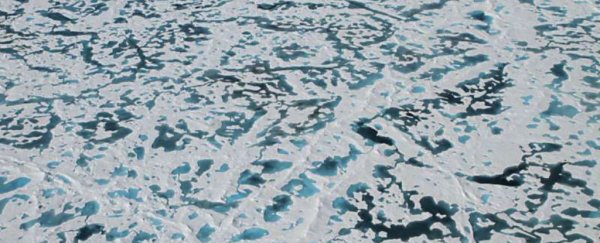Arctic sea ice is turning progressively greener, and for years now, scientists couldn't for the life of them figure out what was going on.
They knew the green had to come from blooms of microscopic marine plants called phytoplankton growing under the sea ice, but that didn't make sense - phytoplankton need light to photosynthesise, and it should have been far too dark for them to survive down there, let alone thrive.
Now, an international team of researchers has cracked the mystery, and the truth is pretty unsettling.
The record low levels of sea ice we now see in the Arctic have worn down the barrier for sunlight, so instead of being reflected, it's being absorbed by dark melt pools that are proliferating on the surface.
The ice that remains is now darker and thinner than ever before, and below, phytoplankton colonies are booming as light penetrates the ocean below.
"[W]e went from a state where there wasn't any potential for plankton blooms to massive regions of the Arctic being susceptible to these types of growth," says one of the team, Chris Horvat from Harvard University.
Because satellites aren't able to peer through the ice to see the conditions underneath, Horvat and his colleagues had to come up with another way to get their answers.
Using mathematical modelling, they built a computer simulation of sea ice conditions from 1986 through to 2015, and confirmed that not only was the ice thickness decreasing, but the melt pools were increasing.
These twin pressures delivered a two-pronged attack that has been increasing in intensity over the past couple of decades - and is showing no signs of slowing down.
As darkness absorbs more light than unmelted sea ice - which is bright and reflective in its pristine form - the proliferation of these melt pools has allowed unprecedented levels of sunlight to permeate the thinning ice and reach the ocean below.
The team's simulation revealed that 20 years ago, just 3 or 4 percent of Arctic sea ice was thin enough to allow large colonies of plankton to bloom underneath.
Fast-forward to 2015, and nearly 30 percent of Arctic sea ice was thin enough to let phytoplankton blooms crop up in the summer months - and the melt is continuing to hit record levels today.
The concern now is that these green phytoplankton blooms aren't just a harmless side effect of the melting sea ice - they bring with them a whole different set of problems because of how crucial they are to the local ecosystem.
If conditions in the Arctic start making conditions below the sea ice hospitable for phytoplankton, and they continue to show a preference for it as they apparenty have in recent years, they will make themselves unavailable to the larger sea creatures that depend on them as a food source.
"The metre decline in sea ice thickness in the Arctic in the past 30 years has dramatically changed the ecology in that area," says Horvat.
"All of a sudden, our entire idea about how this ecosystem works is different. The foundation of the Arctic food web is now growing at a different time and in places that are less accessible to animals that need oxygen."
It's not clear what will happen next, but it's likely that the 'greening' will continue, with researchers reporting that we're losing Arctic sea ice across all seasons.
And that won't just have consequences for the region itself - the knock-on effect elsewhere will be what we'll really have to worry about.
"What happens in the Arctic doesn't stay in the Arctic," Texas Tech climate scientist Katharine Hayhoe told the press earlier this month.
"This entire planet is interconnected."
The research has been published in Science Advances.
